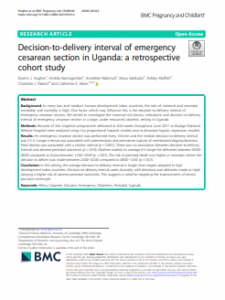
Background
In many low and medium human development index countries, the rate of maternal and neonatal morbidity and mortality is high. One factor which may influence this is the decision-to-delivery interval of emergency cesarean section. We aimed to investigate the maternal risk factors, indications and decision-to-delivery interval of emergency cesarean section in a large, under-resourced obstetric setting in Uganda.
Methods
Records of 344 singleton pregnancies delivered at ≥24 weeks throughout June 2017 at Mulago National Referral Hospital were analysed using Cox proportional hazards models and multivariate logistic regression models.
Results
An emergency cesarean section was performed every 104 min and the median decision-to-delivery interval was 5.5 h. Longer interval was associated with preeclampsia and premature rupture of membranes/oligohydramnios. Fetal distress was associated with a shorter interval (p < 0.001). There was no association between decision-to-delivery interval and adverse perinatal outcomes (p > 0.05). Mothers waited on average 6 h longer for deliveries between 00:00–08:00 compared to those between 12:00–20:00 (p < 0.01). The risk of perinatal death was higher in neonates where the decision to deliver was made between 20:00–02:00 compared to 08:00–12:00 (p < 0.01).
Conclusion
In this setting, the average decision-to-delivery interval is longer than targets adopted in high development index countries. Decision-to-delivery interval varies diurnally, with decisions and deliveries made at night carrying a higher risk of adverse perinatal outcomes. This suggests a need for targeting the improvement of service provision overnight.